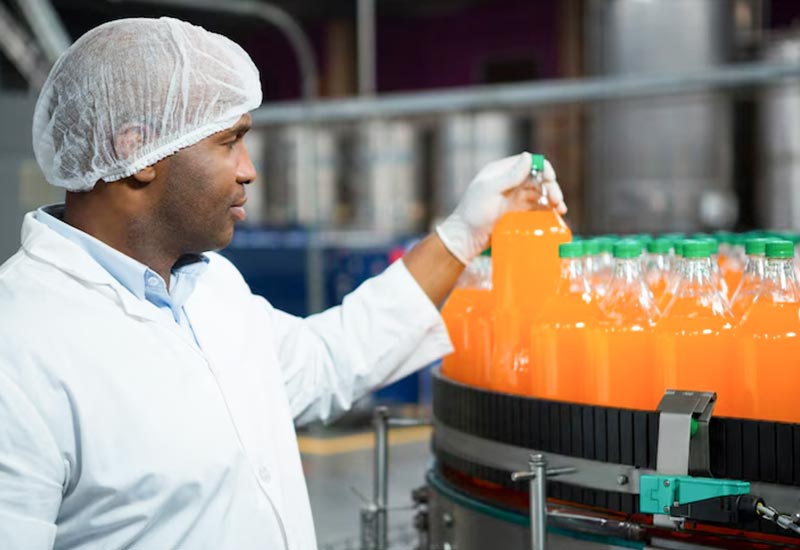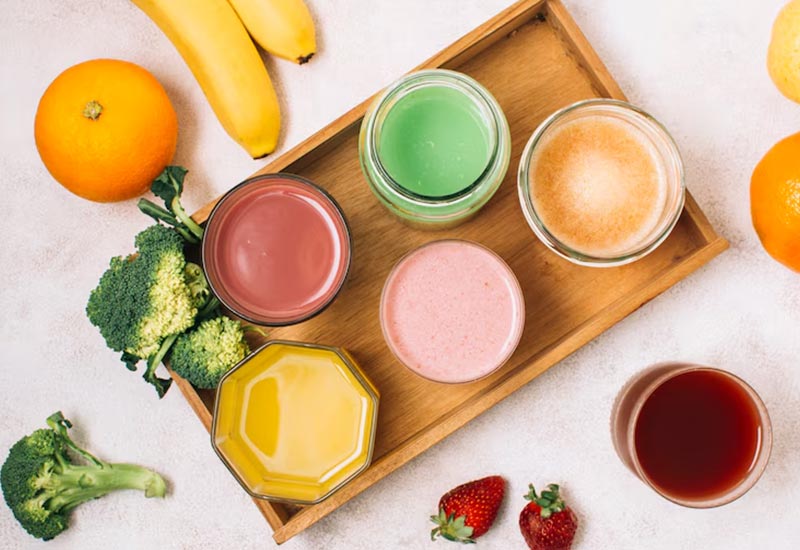Juice is one of the most widely consumed beverages globally, prized for its flavor, nutrition, and convenience. But behind the vibrant color and fresh taste of packaged juices lies a complex formulation involving various food additives. These additives are essential to ensure stability, safety, sensory appeal, and shelf life of juice products. As a food additive manufacturer, understanding what juice factories need can help you better meet market demand and establish strong B2B partnerships.
This article explores the types of food additives used in juice production, their functional roles, regulatory considerations, and the emerging trends juice manufacturers follow in selecting additives.

Why Juice Factories Need Food Additives
While fresh-pressed juice is ideal in artisanal or home settings, it’s impractical for commercial-scale production due to spoilage, oxidation, sedimentation, and microbial growth. Food additives help solve these problems in ways that are cost-effective and compliant with food safety standards.
Core needs of juice factories include:
- Prolonged shelf life without refrigeration
- Color and flavor retention
- Sediment stabilization
- Microbial safety
- Enhanced nutritional profile
- Appealing sensory characteristics
Additives are carefully selected and dosed to meet these needs without compromising juice integrity.

Key Categories of Additives Used in Juice Production
Preservatives
Preservatives prevent microbial spoilage and oxidative degradation. Without them, juice has a very limited shelf life.
Common preservatives in juice:
- Potassium Sorbate (E202): Inhibits yeast and mold; highly effective in acidic juices like orange or apple.
- Sodium Benzoate (E211): Works well in low pH environments; often used in citrus juices.
- Ascorbic Acid (Vitamin C, E300): Dual role as antioxidant and mild preservative.
- Sulfur Dioxide (E220): Used primarily in fruit concentrates (e.g., grape juice) to prevent discoloration and microbial growth (note: has allergen labelling requirements).
These preservatives must be dosed within legal limits set by FAO/WHO Codex Alimentarius, FDA, or EFSA, depending on the market.
Acidulants and pH Regulators
Acidulants adjust the juice’s acidity to optimize flavor, inhibit microbial growth, and improve shelf stability.
Widely used acidulants:
- Citric Acid (E330): Naturally found in citrus fruits; enhances tartness and acts as a preservative.
- Malic Acid (E296): Found in apples and grapes; used to create a balanced sour note.
- Tartaric Acid (E334): Mainly in grape-based juices or blends.
- Phosphoric Acid (E338): Occasionally used in fruit-flavored beverages to give a tangy note.
Maintaining optimal pH (usually 3.0–4.5) is crucial for both taste and microbial control.
Colorants
Color is one of the first sensory cues for consumers. In some cases, natural juice loses color due to processing or oxidation.
Common colorants:
- Anthocyanins (E163): Extracted from grapes, berries, or red cabbage; give a red-purple hue.
- Carotenoids (E160a): Natural orange-yellow pigments (like beta-carotene).
- Paprika Extract (E160c): Used for reddish-orange hues.
- Caramel Color (E150): For dark-colored drinks or blends (e.g., apple-grape blends).
Juice factories are shifting toward natural colorants over synthetic ones like Sunset Yellow (E110) and Allura Red (E129) due to consumer demand for “clean-label” products.
Flavorings and Flavor Enhancers
Flavor consistency is vital, especially for multi-fruit blends or reconstituted juices. Additives help standardize taste across batches.
Types of additives used:
- Natural flavors: Extracts from orange, mango, lemon, etc.
- Nature-identical flavors: Chemically identical to natural components (e.g., ethyl butyrate for pineapple).
- Flavor enhancers: Substances like monosodium glutamate (MSG) are rare in juices but some blends may use glycine or nucleotide-based enhancers to modify mouthfeel.
Juice manufacturers often work with flavor houses or additive suppliers to develop custom flavor systems.
Antioxidants
Oxidation can cause off-flavors, browning, and loss of nutritional quality. Antioxidants help maintain product integrity.
Essential antioxidants:
- Ascorbic Acid (E300): Also boosts Vitamin C content.
- Tocopherols (Vitamin E, E306–E309): Used in oil-rich juice blends or emulsions.
- Citric acid and EDTA (E385): By binding metal ions, chelating agents stabilize flavor and color.
Stabilizers and Emulsifiers
Many juices contain pulp, added fibers, or oil-soluble vitamins that require suspension or emulsification.
Popular stabilizers include:
- Pectin (E440): Adds viscosity, mouthfeel, and pulp suspension in citrus juices.
- Xanthan Gum (E415): Effective thickener with good shear resistance.
- Guar Gum (E412), Locust Bean Gum (E410): Used for pulp-containing beverages.
- Glycerol Esters of Wood Rosin (E445): Keeps citrus oils in suspension in cloudy drinks.
These ingredients prevent separation and sedimentation, improving visual appeal and uniformity.
Sweeteners
Even fruit juices may need sweetness adjustment depending on source material or target market. Sugar replacements are common in low-calorie juices.
Used sweeteners:
- Sucrose (table sugar): The standard in most regular juices.
- High-Fructose Corn Syrup (HFCS): Economical but controversial.
- Stevia (E960), Sucralose (E955), Acesulfame K (E950): Non-caloric alternatives for “diet” or “light” juices.
- Fructose or glucose syrup: For adjusting sweetness and mouthfeel.
Careful blending of high-intensity sweeteners with bulking agents like maltodextrin ensures desirable flavor profiles.
Nutritional Fortifiers
To increase the functional value of juice, fortification with vitamins and minerals is common.
Additives for enrichment:
- Vitamin C (Ascorbic Acid)
- Vitamin A (Retinyl Palmitate)
- Vitamin D
- Calcium salts (e.g., calcium citrate, calcium lactate)
- Iron (e.g., ferrous gluconate)
This is especially relevant for “functional juices” targeting children, athletes, or wellness consumers.
Juice Additive Use by Product Type
Here’s how additives vary across major juice categories:
| Juice Type | Common Additives |
| Orange Juice | Citric acid, ascorbic acid, pectin, beta-carotene |
| Apple Juice | Malic acid, potassium sorbate, caramel color |
| Mixed Fruit Juice | Natural flavors, colorants, stabilizers, sweeteners |
| Functional Juice | Vitamins, minerals, stevia, antioxidants |
| Cloudy Juice | Gums, glycerol esters, pectin for suspension |
| Reduced Sugar Juice | Non-nutritive sweeteners, acids, flavor boosters |
As a food additive manufacturer, you can target juice producers by offering tailor-made additive systems for specific juice types.
Regulatory and Labeling Considerations
Each region has strict laws on allowable food additives:
- United States (FDA, CFR 21): Prescribes permissible additives and usage levels. Requires clear labeling (e.g., “contains sodium benzoate”).
- European Union (EFSA): Uses E-numbers; has stricter policies on synthetic colorants and preservatives.
- China (GB Standards): Mandatory testing and registration for additives.
- Codex Alimentarius (FAO/WHO): Provides global guidance for international trade.
Compliance includes:
- Maximum Residue Limits (MRLs)
- Acceptable Daily Intake (ADI)
- “Clean Label” alternatives
- Allergen declarations
Trends Driving the Choice of Additives in Juices
As the juice industry evolves, so do additive requirements. Key trends include:
Clean Label Formulations
Removal of artificial colors/flavors.
Shift from sodium benzoate to natural alternatives like fermented acerola extract.
Low-Calorie and Keto-Friendly Juices
High demand for stevia, erythritol, and monk fruit extract.
Functional and Fortified Beverages
Additives like zinc, magnesium, collagen peptides, or probiotics are growing in popularity.
Plant-Based and Organic Certification
Organic-certified additives (e.g., organic pectin, natural tocopherols) are required for organic juice brands.
How Food Additive Manufacturers Can Support Juice Factories
As a food additive supplier, your role is not limited to product delivery. Value-added support includes:
- Technical formulation guidance
- Customized additive blends (e.g., flavor-color-stabilizer systems)
- Regulatory documentation (MSDS, CoA, organic compliance)
- R&D collaboration for product innovation
- Logistics and shelf life optimization
Building long-term relationships with juice factories requires offering reliability, safety, and innovation in your additive portfolio.
Juice factories depend on a wide variety of food additives to ensure product stability, safety, and sensory appeal. From preservatives and acidulants to flavorings and fortifiers, each category plays a vital role in juice formulation. As a food additive manufacturer, aligning your offerings with the functional and regulatory needs of juice factories will help you become an essential part of the juice production value chain.
By staying ahead of trends like clean labeling, sugar reduction, and functional beverages, your business can provide the tailored solutions that juice brands need to thrive in an increasingly health-conscious and competitive market.
